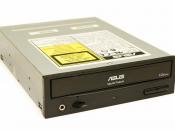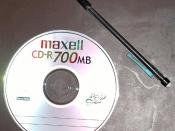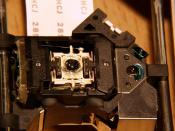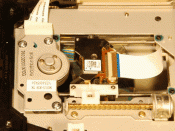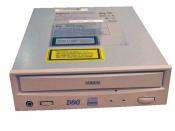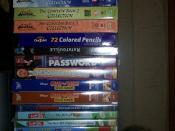UNIT ÃÂ 2,1.The four major components of the motherboard are:A.BIOS;The BIOS (basic input / output system) is basically the "software" the computer uses, it is most basic operations (accessing memory, disks, processors, etc.). This "software" is built into the computer's motherboard, so do not worry about losing it if your hard drive crashes.
Most BIOS setups allow you to configure hard drive parameters, set the time, type of floppy disk drives, memory timing and so on. It is an area that's best left alone unless you are an experienced computer user.
(Note that these are NOT Windows settings, these are the "core" settings for your computer. You normally can get at them by pressing the DEL key a few seconds after you turn your computer on (this can vary from machine to machine though).
B.CMOS Memory:CMOS (complementary metal oxide semiconductor) is a low powered memory chip. Even when the computer is turned off, CMOS is running.
The CMOS chip has its own battery, that will last 7 to 10 years. Once the battery dies all configuration information will be lost and will have to be re-entered.
C.RAM Slots:RAM (Random Access Memory) and is pronounced like the male sheep. RAM is made up of small memory chips that form a memory module. These modules are installed in the RAM slots on the motherboard of your computer. Every time you open a program, it gets loaded from the hard drive into the RAM. The more RAM your computer has, the more data can be loaded from the hard drive into the RAM, which can effectively speed up your computer. In fact, adding RAM can be more beneficial to your computer's performance than upgrading the CPU.
To check how much RAM a Windows computer has, open the Control Panel. This can be done by right-clicking "My Computer" and selecting "PropertiesÃÂ.
D. Parallel Port:This interface is found on the back of older PCs and is used for connecting external devices such as printers or scanners. It uses a 25-pin connector and is rather large compared to most new interfaces. It is sometimes also referred to as a printer port, because the printer is the device most commonly attached to the parallel port. The latest parallel port is called the Enhanced Parallel Port (EPP). This standard supports bi-directional communication and can transfer data up to ten times faster than the original 25-pin connector port. Since the parallel port is a rather dated technology, do not be surprised to see USB or Firewire interfaces completely replace parallel ports in the future.
1.Describe the CPU and provide a picture;CPU (Central Processing Unit), this is the pretty much the brain of your computer. It processes everything from basic instructions to complex functions. Any time something needs to be computed, it gets sent to the CPU. Every day it is compute this, compute that (you would think the CPU would need a break after awhile). But no, it just keeps on processing. The CPU can also be referred to simply as the "processor."2.Describe expansion slots and provide a picture;Expansion slots are openings in a circuit board where you can insert new capabilities to the computer. Nearly all personal computers, except portables, contain expansion slots for adding more memory, graphics capabilities and support for special devices. The boards inserted into the expansion slots are called expansion boards, expansion cards, cards, add-ins and add-ons. Expansion slots for PCs come in two basic sizes: half and full-size. Half-size slots are also called 8-bit slots, because they can transfer 8 bits at a time. Full-size slots are sometimes called 16-bit slots.
3.Basic computer parts including a picture and definition of each.
A.Monitor- orThe monitor displays the computer's user interface and open programs, allowing the user to interact with the computer.
B. Keyboard-The design of computer keyboards may have come from typewriters, today's keyboards have many other keys as well. Modifier keys, such as Control, Alt/Option, can be used in conjunction with other keys as "shortcuts" to perform certain operations. For example, pressing Control-S (Windows) typically saves a document or project you are working on. Most of today's computer keyboards also have a row of function keys (F1 through F12) along the top of the keyboard, arrow keys arranged in an upside-down T, and a numeric keypad on the right-hand side. Some keyboards have even more buttons, allowing you to change the system volume, eject a CD, or open programs such as your e-mail or Web browser.
C. Mouse-The name comes from the small shape of the mouse, which you can move quickly back and forth on the mouse pad, and the cord, which represents the mouse's tail. All mice have at least one button, though most mice have two or three. Most mice also have a scroll-wheel, which lets you scroll up and down documents and Web pages by just rolling the wheel with your index finger.
D. System Unit-This is the technical term that refers to the box that houses your computer. The system unit refers to the computer itself, but does not include; the monitor, the keyboard, the mouse, or any other input/output devices.
E. Hard Drive-The hard drive is what stores all your data. It houses the hard disk, where all your files and folders are physically located. The data is stored on a stack of disks that are mounted inside a solid encasement. These disks spin extremely fast (typically at either 5400 or 7200 RPM), so that data can be accessed immediately from anywhere on the drive. The data is stored on the hard drive magnetically, so it stays on the drive even after the power supply is turned off.
F. Floppy Drive-A floppy disk drive or FDD, the initials of which should not be confused with "fixed disk drive," is another term for a non removable type of hard disk drive. Invented by IBM, floppy disks in 8-inch (200 mm), 5ü-inch (133.35 mm), and 3ý-inch (90 mm) formats enjoyed many years as a popular form of data storage and exchange, from the mid-1970s to the late 1990s. While floppy disk drives still have some limited uses (especially with industrial computer equipment), FDDÃÂs have now been largely superseded by USB flash drives, external hard drives, CDs, DVDs and memory cards.
G. CD/DVD drive-CD-ROM (Compact Disc Read-Only Memory), a CD-ROM is a CD that can be read by a computer with an optical drive. The "ROM" part of the term means the data on the disc is "read-only," or cannot be altered or erased. Because of this feature and their large capacity, CD-ROMs are a great media format for retail software. The first CD-ROMs could hold about 600 MB of data, but now they can hold up to 700 MB. CD-ROMs share the same technology as audio CDs, but they are formatted differently, allowing them to store many types of data.
DVD (Digital Versatile Disc) or (Digital Video Disc), but with the many uses of DVDs, the term "Digital Versatile Disc" is more correct. A DVD is a high-capacity optical disc that looks like a CD, but can store much more information. While a CD can store 650 to 700 MB of data, a single-layer, single-sided DVD can store 4.7 GB of data. This enables massive computer applications and full-length movies to be stored on a single DVD. There is a two-layer standard that doubles the single-sided capacity to 8.5 GB. These disks can also be double-sided, ramping up the maximum storage on a single disc to 17 GB. That's 26 times more data than a CD can hold. To be able to read DVDs in your computer, you will need a DVD-ROM drive. To play DVD movies on your computer, you will need to have a graphics card with a DVD-decoder, which most computers now have.
H. Serial Ports-The serial port is a type of connection on PCs that is used for mice, gaming controllers, modems and older printers. It is sometimes called a COM port or an RS-232 port, which is its technical name. If that's not enough to confuse you, there are two types of serial ports; DB9 and DB25. DB9 is a 9-pin connection, and DB25 is a 25-pin connection.
The serial port is typically the slowest port you will find on a PC, if you find one at all. Most new computers have replaced serial ports with much faster and more compatible USB ports.
I.DIN connector-J. Ethernet ports-Ethernet is the most common type of connection computers use in a local area network (LAN). An Ethernet port looks much like a regular phone jack, but it is slightly wider. This port can be used to connect your computer to another computer, a local network, or an external DSL or cable modem.
K. USB port-USB (Universal Serial Bus) is the most common type of computer port used in today's computers. It can be used to connect keyboards, mice, game controllers, printers, scanners, digital cameras and removable media drives (just to name a few). With the help of a few USB hubs, you can connect up to 127 peripherals to a single USB port and use them all at once (though that would require quite a bit of dexterity). USB is also faster than older ports, such as serial and parallel ports.
References:Kozierok, Charles M. (2001, April 17). ÃÂCMOS MemoryÃÂ PC Guide. Retrieved September 26, 2009, from Web site: www.pcguide.comRetrieved images from ÃÂFotosearchÃÂ on September 27, 2009, from www.fotosearch.com/photos-imagesRetrieved images from ÃÂExpedientÃÂ on September 27, 2009, from www.expedient.comSchmidt, C. A. (2008). ÃÂThe Complete A+ Guide to PC RepairÃÂ, Fourth Edition. Boston: Addison-Wesley.
